
Purpose The purpose of this study is to analyze issues of sexual violence case in sports field reported in the press by using spline function model and text mining. In specific, spline function model is used to measure social interest level based on issue attention cycle theory and figure out the flow of issues by applying text mining. Methods Study material is 2,660 news articles reported from January 1, 2017 to December 31, 2019 and press DB(Big Kinds) of Korea Press Foundation is used to collect study material. Results Social interest level on sexual violence case in sports field is dramatically increased due to disclosure of Sim player starting from Me Too movement started from the culture and art world. Because of this, as structural problem in sports field arises, social interest level comes to a climax, and then it was founded that the government’s countermeasures establishment and special audits by the Ministry of Education were in progress. From the perspective of the issue attention cycle, it has the stages of latent-occurrence-rising-decision-decay-disappearance, but the period from rising to declining is short, so it corresponds to a breaking issue attention cycle. Conclusion This study examines the progress of sexual violence case in sports field from rising to disappearance in the perspective of the issue attention cycle. With this incident, the world of sports is establishing sports ethics center and proceeding policies such as Basic Sports Act, and the future studies need to review the effectiveness of this policy.

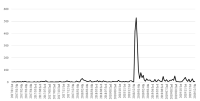
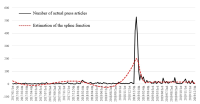

Purpose This is to provide essential data for training necessary for sweeping through the analysis of muscle activity generated at this time and how much sweeping and what trajectory moves the stone when the movement of the stone is controlled through sweeping. Methods To check and record the distance between the stones by checking the stop position of the stone made by sweeping each section, the length (progress distance) and width (progress direction) were recorded using a reference table and a record preparation table. With the EMG attached, a total of 60 sweeps were made 20 times each from the beginning of the section to the end of the section. Sweeping subjects were asked to sweep as much as possible under the same conditions in all three sections. Results As a result of the study, the muscle mobilization patterns of the 1st and 2nd sections of the stone with the faster speed and the 3rd section with the stone's slower speed appeared differently. It was confirmed that the sweeping motion of curling is a motion that is used evenly among the muscles of the upper extremity, and it can be verified that it is a suitable item for the development of upper body muscles. Also, the right deltoid's muscle activity rate during push and the right triceps brachii during pull was high. Conclusion Each section of the stone's sweeping effect is an exercise that has many variables, such as changes in atmospheric temperature and humidity, changes in ice temperature, temperature-size-number of pebbles, and the edge state-resilience of stones, etc. It is judged that experience can cope with these variables and requires training.

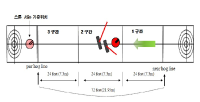

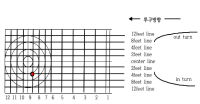
Purpose The purpose of this study is to analyze the performance contents of men's floor exercise and to provide basic materials for achieving excellent results at world competitions. Methods Teams ranked 1 - 12 who participated in the World Championships' floor movement group competition selected a total of 59 players by the convenience sampling method and carried out technical statistics, frequency analysis, member variable variance analysis, and post hoc analysis. Results First, as a result of frequency analysis of the difficulty of each group, all the teams ranked 1 to 12 liked the most difficulty of C and found that they do not like the F difficulty the most. Secondly, there was a difference in average for each group's start score, ranking 1st to 4th> 5th to 8th> 9th to 12th place. Thirdly, there was a difference in average of difficulty levels for each group B, C, E, and it became very significant with E difficulty.Results of post hoc analysis B difficulty (9th to 12th> 1st to 4th, 5th to 8th), C difficulty (9th to 12th> 1st to 4th), E difficulty (1st to 4th> 5th to 8th ·9th to 12th). Conclusion These results show that in floor exercise, the art of more than C difficulty and the connection technology of A, B, C, difficulty, E and F, difficult difficulty such as difficulty, creative and dynamic performance composition is excellent It clearly states that it is a condition for getting results.
PURPOSE This study aimed to identify movement pattern differences in the running of youth soccer players with and without lateral ankle sprain (LAS) histories. METHODS A total of 12 participants were recruited and assigned to the LAS group or the control group. All participants were assessed for anthropometric data, and they filled in the subjective ankle function questionnaires. Then, reflective markers were attached to their bodies, and they were instructed to run at the preferred speed on the 9-m runway thrice. 3D joint angles for ankle, knee, and hip joints were exported, and their mean values and 95% confidence intervals were calculated. Ensemble curve analysis was conducted to compare running kinematics between the groups. RESULTS The LAS group exhibited fewer dorsiflexion angles and more inversion angles compared to the control group. Excluding the dorsiflexion deficits and more inverted ankles, there were no significant differences between the groups. CONCLUSIONS Although the ankle kinematic patterns found in this paper are not considered LAS risk factors, it will be able to identify precise LAS risk factors with prospective design (e.g., lower extremity movement patterns) as well as intrinsic risk factors.
PURPOSE The purpose of this study was to verify the support effect of muscle activity and stability according to walking conditions (Level, Ramp, and Stair) before and after wearing a suit with a 12kg heavy weight load. METHODS To accomplish the purpose of the study, subjects (n=10) underwent Electromyography (EMG) measurement under the same conditions for 10 different muscles, and COP width was calculated through foot pressure measurement. The experimental movement was level walking, Ramp walking, and stair walking, each carrying a 12kg load, and measured once before and after wearing a wearable suit. RESULTS Electrolyography (EMG) measurement revealed a significant difference in the average EMG values of muscle activity of R.RF in level walking(p<.05), R.RF and L.RF in ramp walking(p<.01), L.RF and L.BF in stair walking (p<.05). COP width measurement revealed a significant difference in the reduction of COP width in all walks (level walking, ramp walking, stair) (p<.05, p<.01, p<.001). CONCLUSIONS The effects of wearing a wearable suit are as follows. First, the wearable suit has a significant effect of assisting the Rectus Femoris muscle. Second, there is a gait stability effect by wearing a wearable suit.
PURPOSE This study aimed to explore the functional movement in rope climbing. METHODS The rope climbing experiment included 16 healthy young male participants, and the methods of hand, cross-leg, and foot-hooking climbing were employed. The muscle activity and joint range of motion were measured and analyzed using EMG (Electromyography) and IMU (Inertial Measurement Unit) sensors. One-way analysis of variance was conducted (α<.05). RESULTS The activity of the forearm and biceps muscle was lower in cross-leg and foot-hooking climbing compared to hand climbing (p<.01), and the rectus femoris muscle activity in cross-leg climbing was smaller than that in hand climbing (p<.05). Furthermore, the adductor muscle activity in cross-leg climbing was higher than that of other types (p<.01). The range of motion for the elbow and shoulder flexion was smaller in hand climbing than in other types (p<.05); furthermore, the range of motion in the pelvis, thigh, and knee joint was the smallest in cross-leg climbing (p<.05). CONCLUSIONS Because the pulling muscles such as the forearm, biceps, pectoralis major, and latissimus dorsi play an important role in the entire climbing motion, it is necessary to train the upper-body pulling-muscle group along with strengthening the core and lower body muscles.

The human foot is only part that directly contact between the body and the external environment, and is ideally positioned to provide sensory information to the Central Nervous System (CNS) during static and dynamic tasks. Through cutaneous mechanoreceptors located in the dermis, the foot is able to recognize touch pressure and vibration stimuli, which provide important feedback information used for the fine coordination of movements. The purpose of this study is to quantitatively examine the effect of changing the foot cutaneous sensory by temperature stimulus on maximal performance and muscle activation using wavelet technique. Sixteen healthy subjects volunteered to participate in this study (Male: Age 21.4±2.4years; Height 174.7±5.3츠; Weight 70.6±5.2kg; Female: Age 20.5±0.6years; Height 163.2±3.1cm; Weight 55.6±4.8kg). Sensory pressure thresholds were determined for the plantar surface of the foot using monofilament. Kinematic, kinetic and EMG data which relative to maximal performance were collected while squat jumping in each temperature condition(cool 12-15℃ normal 28-30℃ hot 45-48℃). Maximal jump height was significant higher in normal condition. Vertical GRF in normal condition showed higher peak value the other conditions. And then EMG signal were significant different between temperature conditions during maximal performance. By changed sensory feedback on temperature, one can alter maximal performance and muscle activation pattern. Cutaneous feedback is important in performance and neuromuscular control, and temperature changes significantly influence on lower extremity during maximal squat jump performance of healthy subjects.

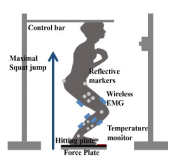




PURPOSE This study aimed to investigate the effects of trunk stabilization exercise (TSE) with abdominal expansion maneuver (AEM) that lasted for 8 weeks on postural stability and functional movement in college athletes. METHODS Twenty college athletes participated in the program (AEM=9, Control=11) and were subjected to 8-week TSE. The AEM group performed exercise by applying AEM techniques during TSE, and control group performed TSE without breathing-related instructions. Both groups measured postural stability with lower-quarter Y-balance test (LQYBT) and functional movement with functional movement screen (FMS) before and after applying TSE to verify the interaction before and after this study with the two groups. Two-way repeated analysis of variance was performed to evaluate the differences between groups and time for an absolute value of LQYBT and FMS, followed by Bonferroni’s multiple comparison tests for post-hoc analysis. RESULTS As a result of the left and right LQYBT, there was a significant difference between the time x group (p=.041, p=.033), and post-hoc analysis indicated that there was a significant difference between the AEM and control groups (p=.000, p=,000). Furthermore, the FMS total score indicated that there was a significant difference between the time × group (p=.039), and the post-hoc analysis showed the AEM group had significant results (p=.001), while there were no significant results in the control group (p=.255). CONCLUSIONS Application of AEM during TSE seems to be effective with regard to postural stability and functional movement in college athletes.
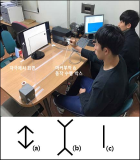
[Purpose] Perception plays an important role in understanding the environment or related objects in order for humans to perform physical movements more effectively. Sometimes they create different movements with different perceptions. Especially, visual perception errors that occur in sports situations can have a considerable effect on performance. Accurate knowledge of the environment in this process of perception is important in performing movements or actions. The purpose of this study was to investigate the effect of learning formation on perception using Muller-Liar illusion diagrams. To measure this, we compared the feedback group that induced knowledge learning and the control group that did not provide knowledge To see if there is a difference. Therefore, in this study, we have provided a visual feedback that can establish the cognitive awareness of the actual stimuli length to subjects, and investigated the changes in their matching action responses. [Methods] A total of 32 young and healthy subjects were randomly divided into two groups (Feedback and Non-Feedback groups). Subjects were asked to match the stimulus size with their index fingers and thumbs. Initially (pre-test), three different visual stimuli (inward, outward, and no arrows) were randomly presented 60 times (20 times each) and the grip sizes were recorded using the Liberty Motion Analysis System (Polhemus Co., America). Then, video clips of two lines merging each other were presented as feedbacks. Post-test protocol was identical to the pre-test protocol. The data were analyzed using the 3-way ANOVA with one RM factor (2 x 3 x 2). [Results] Results showed a significant 2-way interaction effect. Post-hoc results showed significant interaction between stimulus shape and pre/post-tests only in the experimental group. There was a significant decrease in the grip size after feedback in the OUT condition of experimental group. However, in the control group, there was no interaction between stimulus shape and pre/post-tests. [Conclusion] Overall, current results indicates that, while visual illusion can affect the action, the provision of visual feedback can establish the awareness of actual stimulus size and suppress the influence of illusion on action.

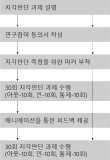

PURPOSE Using GPS data from actual field hockey matches, this study examined the effects of position and substitution time on the physical performance of elite female players. METHODS From 25 matches played in 2023, data involving 26 players were collected. Players’ positions were classified as forwards (FW), midfielders (MF), and defenders (DF). Substitution times were segmented into 5, 10, and 15 minutes, respectively. A two-way ANOVA was employed to analyze movement patterns across different exercise intensities as influenced by player position and substitution time, followed by Bonferroni post-hoc tests for further detailed analysis. RESULTS Analysis revealed that both position and substitution time significantly affected exercise intensity. Notably, at a substitution time of 5 minutes, substantial differences were observed in high-intensity movements, including the distance covered at high-intensity and the frequency of high-intensity efforts. Furthermore, the substitution time’s impact was particularly pronounced among forwards and midfielders. CONCLUSIONS Findings suggest that shorter substitution times can enhance players’ active movement, thereby supporting maintenance of tactical adjustments and positively influencing overall performance. Implementing shorter substitution times could be particularly beneficial for optimizing team performance, especially for players in forward positions.